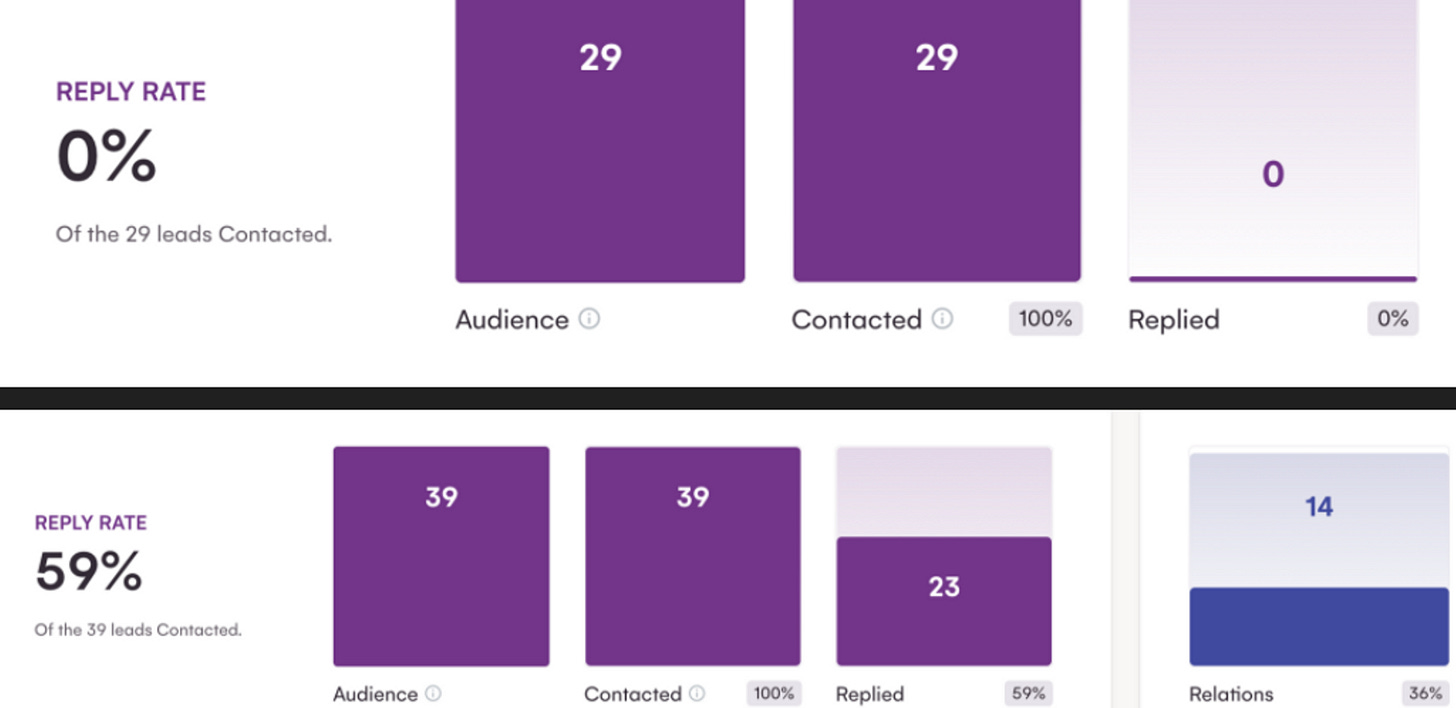Welcome to the 5th edition of Scale with Outbound. (if you want to follow my new case studies, you can follow me on LinkedIn).
👋 Warm welcome to the new joiners!
In this newsletter, you will :
Discover how I help my clients reach out to their target customers to book more qualified meetings and generate revenue.
Access my document, processes, experiments, learnings, and failures.
👉 Grab my lead gen automation templates here.
I'm sharing my learning here with you.
Summary :
Introduction
Targetting + ultra segmentation
Copywriting
Set up relaunches
The true method of knowledge is experiment
William Blake
Introduction
Back in 2017 as an SDR, my phone was my only weapon for managing sales cycles from prospective to closing.
As a big experimentation fan and after two years of experiments, I achieved a 40% + reply rate to drive business opportunities.
2021: My first cold outreach campaign
2023: Current status
Targeting + ultra segmentation
First of all, it is essential to define your target.
Who are your prospects?
What are their needs and expectations?
Where are they located?
What may resonate with them?
I developed this part in my previous article.
You can read what I called the R&D part here.
I’m speaking about the importance of mastering your ideal customer profile and buyer persona.
Quality> Quantity
Keep your audience small but well-segmented.
Here are two methods I’m using to keep my list well-segmented:
Using Airtable
Linkedin Sales Nav’ is a good tool, especially if you are working in B2B space, but building a well-segmented list could be painful as you don’t want to create tons of lists.
Here is how I’m keeping a clean, segmented list:
Use Linkedin Sales Nav filter and filter per account.
Select your leads and create a lead list.
Extract your list to Airtable (I’m using Captain Data and n8n).
Segment your audience manually.
As a second filter, I use a checkbox when I’m sure that the contact is relevant.
I’m targeting CEOs, Marketing & Growth, and Commercial executives, so I’m segmenting my audience to ensure I will split each persona to deliver a unique message that resonates with them.
To do that, I’m using n8n and making a POST request to LaGrowthMachine to 3 separate buckets like this:
(I haven’t posted the workflow on n8n.io now, but let me know if you need it, and I will send you the JSON file)
Search Engine Response Page (SERP) & boolean search
I needed to reach out to a specific C-level audience niched in a particular therapeutic area.
You may easily find the big players, … but you will rapidly understand that this specific area represents less than 10% of the global account size.
This is why I’ve used SERP to be more specific during my search.
I’ve decided to use specific compounds currently developed for specific clinical trials in my particular use case.
Query on google.
site: linkedin.com/in AND "{company_name}" AND "Psychiatric disorder"
site: linkedin.com/in AND "{company_name}" AND "RG6163"
site: linkedin.com/in AND "{company_name}" AND "NME"
site: linkedin.com/in AND "{company_name}" AND "RG7637"
Paste the Query on Scale SERP and extract the CSV
Clean CSV data and import it to Airtable
Run process as usual
Copywriting
I’ll keep this part global focus.
Crafting a unique message means using words that resonate the most with your audience.
Everybody has a unique prism, so using words that impact your prospect is essential.
Imagine you are trying to convince three people to use their bicycles more often:
Your mother is very concerned about the environment and makes donations to Greenpeace.
“ You should use your bike more often because it will reduce the C02 emissions.”
Your brother is very sportive and concerned about his health.
“ I’ve heard about a study saying that using the bike 20’ a day will reduce heart attack by 50%. What about taking your bike to commute to your work ?”
Your Dad wants to lose weight.
“ I read in a scientific journal that cycling is the easiest way to lose weight.”
Know your prospect, and add relevance, and I’m sure this will also work for you.
Experiment, constantly experiment, and create a Copywriting log.
Here is the template I’m using.
Target audience
Status: In progress / Done
Method: Allow me to construct my narrative
Buyer persona + pain point: Related to specific pain point per persona
Referral: Someone recommends getting in touch
ABM: Specific account change (new position, fundraising)
EBM: Specific event (Webinare, …)
+ Reply rate: Positive replies that create engagement
Media: Linkedin or Mail
Business outcomes: Next steps + utility
Getting a reply is a first good step because it drives awareness and sometimes consideration, but it is insufficient.
You always need to think about the business outcomes.
I’ll write a separate post about navigating the prospect between the following steps: awareness > consideration > decision.
Campaign setup:
Money is in the follow-up
Facts:
According to a study by Brevet, 80% of sales require an average of five follow-ups to close the deal.
However, 44% of sales reps follow up with a prospect only once before giving up. After four follow-ups, 94% of salespeople have given up.1
Don't take it personally if a prospect is not replying to your first email.
If you have performed all your searches and have a solution to their problem, be persistent.
Metrics from a past campaign:
The reply rates are getting bigger :
Email 1: 8;5%
Email 2: 18,6%
Email 3: 23,2%
It’s not a generality, just an observation that persistence is vital.
As usual, ping me on Linkedin if you have any questions.
See you next week
Arnaud
https://blog.hubspot.com/sales/sales-follow-up-infographic








